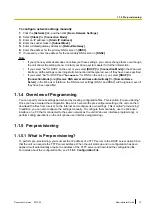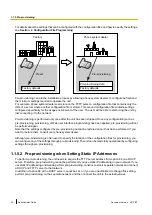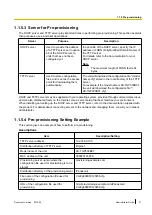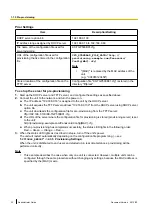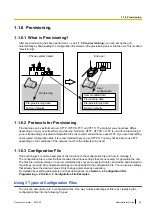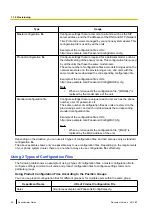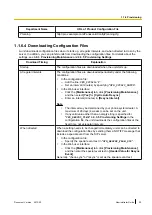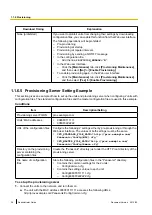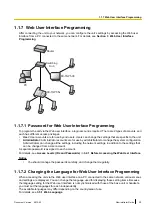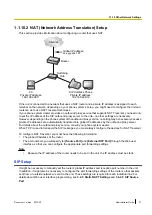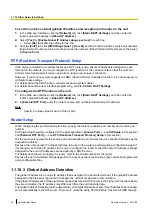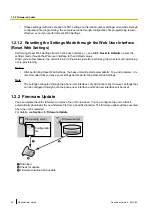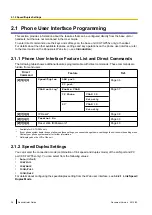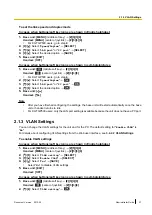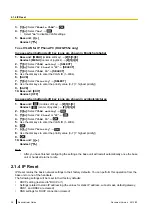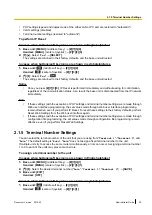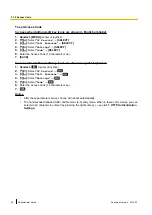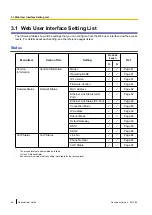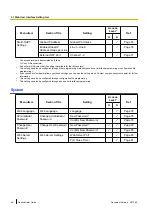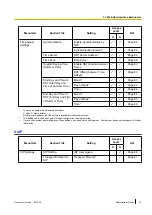
To set the router’s external (global) IP address and reception port number in the unit
1.
In the Web user interface, click the
[Network]
tab, click
[Static NAPT Settings]
, and then enter the
router’s global IP address in
[Global IP Address]
.
2.
Select
[Yes]
for
[Enable Global IP Address Usage per Line]
for each line.
•
Select
[No]
to disable the setting for the line.
3.
Click the
[VoIP]
tab, click
[SIP Settings [Line 1]–[Line 8]]
, and then enter the router’s source port numbers
(forwarded port numbers, which are the same as the numbers of the WAN and LAN ports set on the router)
in
[Source Port]
.
RTP (Real-time Transport Protocol) Setup
If the unit is connected to a network that uses a NAT router and a private IP address is assigned to each
terminal on the network, you must configure the RTP function for the unit and router so that the units can
perform voice transmission between each other using a peer-to-peer connection.
However, if your phone system supports the SBC (Session Border Controller) function, it is not necessary to
configure these settings.
For details about the SBC function, consult your phone system dealer.
For details about Web user interface programming, see
.
To configure the RTP function on the unit
1.
In the Web user interface, click the
[Network]
tab, click
[Static NAPT Settings]
, and then enter the
router’s global IP address in
[Global IP Address]
.
2.
In
[External RTP Port]
, enter the router’s source port numbers (forwarded port numbers).
Note
•
Specify a unique value for each of the 3 ports.
Router Setup
When configuring the port forwarding function, specify the router’s reception port number as the unit’s port
number.
Port forwarding should be configured for the ports specified in
[Source Port]
(
®
in this section)
and
[External RTP Port]
(
®
RTP (Real-time Transport Protocol) Setup
in this section).
Set the same port number for the source port and destination port, and set the unit’s private IP address as the
destination address.
Because the unit’s private IP address will have to be set in the router’s port forwarding configuration again if
it is changed, set a static IP address to the unit, or configure the router so that the same IP address is always
assigned to the unit if IP addresses are assigned by a DHCP server.
For details about how to configure the router, refer to the documentation for the router.
Because the port forwarding settings depend on the user’s network environment, they cannot be programmed
using configuration files.
1.1.10.3 Global Address Detection
The global IP address is a unique IP address that is assigned to a particular terminal. If the global IP address
assigned to the firewall or the router is changed, the unit will not be able to communicate.
If the global IP addresses of these terminals are assigned by a DHCP server in the higher level network where
they are connected, the IP address may differ each time the unit transmits data.
The Global Address Detection feature detects the current global IP address and, if the IP address has changed,
sets it automatically to the SIP server. There are 2 methods, using STUN (Simple Traversal of UDP through
32
Administrator Guide
Document Version 2013-02
1.1.10 Other Network Settings
Содержание KX-TGP500
Страница 224: ...224 Administrator Guide Document Version 2013 02 4 8 Setting Configuration File Parameters Using TR 069 ...
Страница 238: ...238 Administrator Guide Document Version 2013 02 5 3 1 Dial Plan Settings ...
Страница 242: ...242 Administrator Guide Document Version 2013 02 6 4 Local Firmware Update ...
Страница 264: ...264 Administrator Guide Document Version 2013 02 8 3 Example with Incorrect Descriptions ...
Страница 272: ...272 Administrator Guide Document Version 2013 02 ...
Страница 273: ...Section 10 Appendix Document Version 2013 02 Administrator Guide 273 ...
Страница 277: ...Index Document Version 2013 02 Administrator Guide 277 ...


